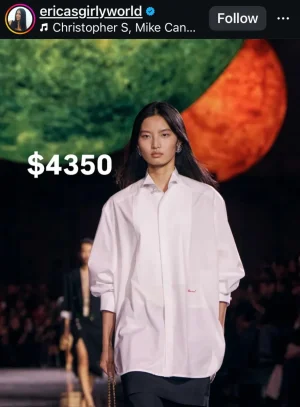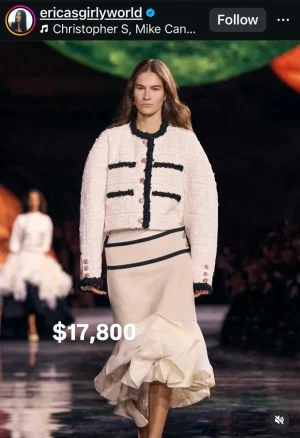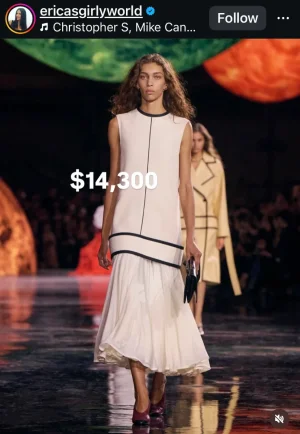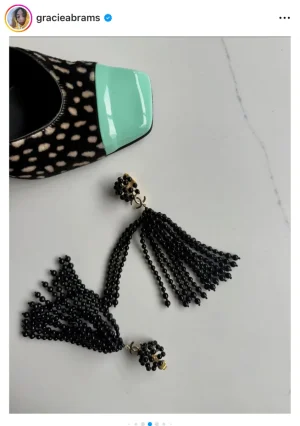Absolutely hideous!! I already despise his Chanel!! I will be screaming from the hill tops “I told you so” everytime I get a chance!! He’s not the right fit for Chanel!! That pyjama set is an eye sore!! I really don’t like his taste in colours they are so harsh and brash!!! Very unlike Chanel!! Very Jarring on the eyes!! This is just the beginning of this mess!! Lord help us all!!
You are using an out of date browser. It may not display this or other websites correctly.
You should upgrade or use an alternative browser.
You should upgrade or use an alternative browser.
Matthieu Blazy - Designer, Creative Director of Chanel
- Thread starter charles01
- Start date
PDFSD
Well-Known Member
- Joined
- Mar 27, 2024
- Messages
- 2,854
- Reaction score
- 10,111
again its lies with the brand if you dont have exclusives you cant be mad if people take contracts somewhere else.Because they aren’t.
I have been fooled by promising or terrible previews before. So I have come to terms that they aren’t indicative of anything.
I have seen more visually challenging things by Karl and Virginie and even Matthieu than those PJ’s.
I don’t have an issue per say with Celebrities and brands. I don’t care for Celebrities unless when they are really friends with the designer.
I have an issue with people going where the wind blows. I have an issue with contract-chasing is too obvious. When you have been the face of a Kering, LVMH to then go to Chanel…come on.
He is cute and he can dress but that’s not the issue.
I don’t think it elevates the celebrities/brands relationship.
for sure KL and VV made ugly stuff but he supposed to be more modern and is younger and he still does these odd ugly stuff
PDFSD
Well-Known Member
- Joined
- Mar 27, 2024
- Messages
- 2,854
- Reaction score
- 10,111
post production will work overtime :-) 1 month left they will make before dec 2 thBut don't you guys get bLazy's deconstruction metaphor here?
PDFSD
Well-Known Member
- Joined
- Mar 27, 2024
- Messages
- 2,854
- Reaction score
- 10,111
post production will work overtime :-) 1 month left they will make before dec 2 th for the NYC subway love store coco and her boy but make it modern and woke ......
heard that they are working overtime now to fix the SS2026 collection first. Client feedback was very negative and SAs were told that the things that will come to store will look different.post production will work overtime :-) 1 month left they will make before dec 2 th
Only time will tell...
Or they can turn to the social media fan base and sell to them?
tricotineacetat
Well-Known Member
- Joined
- Apr 3, 2005
- Messages
- 3,229
- Reaction score
- 4,645
heard that they are working overtime now to fix the SS2026 collection first. Client feedback was very negative and SAs were told that the things that will come to store will look different.
Only time will tell...
Or they can turn to the social media fan base and sell to them?
Haha, by now you can probably imagine the gleeful satisfaction I felt while reading this - I hope you are right! 😌
PDFSD
Well-Known Member
- Joined
- Mar 27, 2024
- Messages
- 2,854
- Reaction score
- 10,111
ah :-) i am not surprised if indeed ...prada used to do post show collections in 1 week right after the show for store proof merchandise , now they put merch ready stuff in collections like miu miu and pille it all on in layers lolheard that they are working overtime now to fix the SS2026 collection first. Client feedback was very negative and SAs were told that the things that will come to store will look different.
Only time will tell...
Or they can turn to the social media fan base and sell to them?
maybe via Raf he can learn the Prada Bertelli way

Lola701
Well-Known Member
- Joined
- Oct 27, 2014
- Messages
- 13,926
- Reaction score
- 37,332
For me the real issue about the collection will be the length of skirts. At least for the runway show.heard that they are working overtime now to fix the SS2026 collection first. Client feedback was very negative and SAs were told that the things that will come to store will look different.
Only time will tell...
Or they can turn to the social media fan base and sell to them?
How different things will look is indeed a question.
It’s true that if the girl of the IG video with tacky style (god forgive me) is unhappy, I’m sure her S.A. is panicking.
Maybe the commercial collection will have more exposure next to the runway show. But it was a gamble and his Chanel will take time to settle.
I can understand that someone who liked the Marseille collection may feel the switch very drastic.
PDFSD
Well-Known Member
- Joined
- Mar 27, 2024
- Messages
- 2,854
- Reaction score
- 10,111
i think people want to feel its chanel but modern and have unexpected elements with each drop and in a way be happy about it, i feel chanel is fun for lots of client and they dont want to overthink every look or feel people have to guess to much its chanel or what they are wearing.For me the real issue about the collection will be the length of skirts. At least for the runway show.
How different things will look is indeed a question.
It’s true that if the girl of the IG video with tacky style (god forgive me) is unhappy, I’m sure her S.A. is panicking.
Maybe the commercial collection will have more exposure next to the runway show. But it was a gamble and his Chanel will take time to settle.
I can understand that someone who liked the Marseille collection may feel the switch very drastic.
this i mean also without relying on logo and it still can be chic and cool and not moschino chanel .
if i was the ceo i would set the frame of first doing hardcore modernist chanel and break it open after the first year step by step, they have so many drops any ways this show was too abrupt and hidden Chanel too clever for the sake of being clever and like it or not chanel is at the service of the client as well its part of the DNA as well as much as being disruptive.
his approach should have been more of first remove the dust and polish what the good and modern pillars are, before remodeling the whole house now it's like a total gutted house.
at the size that it is its risky Chanel Holds As Luxury’s Number Two Brand ,Chanel now has over 600 boutiques Hermès, by contrast, operates some 300 stores.
also seeing with price increases to come on same level as Hermes they should have used this time to make its more luxury and put focus on craft in leather goods and the Chanel ABC in rtw and acc but instead we got decor craft and material and how big chanel is when human scale touch and feeling does better for luxury.
like this part in forbes last year :
A luxury brand like Chanel functions under the Veblen Goods economic model where goods are often bought to signal social status. Economist Thorstein Veblen coined the phrase “conspicuous consumption” in his seminal book The Theory of the Leisure Class in 1899.
Despite protests to the contrary – few will admit they buy a luxury brand as a status symbol, considering it too “nouveau riche” – the status signaling power of a luxury brand is an underlying motivation for many luxury consumers, even if they refuse to admit it.
Under the Veblen model, distribution must be tightly managed to build greater aspiration for the brand. Yes, raising prices is part of conferring luxury aspirational status to a brand, but only a small part.
The heavy lifting is done by creating and maintaining a mysterious allure around the brand with success measured over the long, not the short term
FashionPower
Well-Known Member
- Joined
- Jul 7, 2008
- Messages
- 10,474
- Reaction score
- 4,400
THE SHADE! I am living for it!I can understand that someone who liked the Marseille collection may feel the switch very drastic.
Funnily enough, I think the three RTW collections from the design studio (SS25, Prefall2025, FW25) will turn out being the most commercially successful because they are the perfect status symbol safe collections the brand had in a while.
The balance between status symbol, pushing things forward and merchandise at Chanel is very difficult to mantain and in my opinion, only Karl mastered it.
Let's face it, the conventional Chanel RTW customer who splurges 100k per collection and wear Chanel like it's Zara is loving the tacky oversized pearl logo ankle boots, the bow mini Kelly with the oversized CC clasp and the glittery tweed fitted jacket.
You cannot expect from a bored Texas lady who inherited billions from his passed away hubby who made a fortune in an oil company, that has built a 1mil worth Chanel closet over the past two decades filled with Karl jackets, sequined seasonal classic flap and logo bijoux, to be amused by crashed 2.55s, leather scraps pompoms, slouchy proportions and silly looking earrings featuring a baby chick miniature. Of course this debut collection has destabilized the conventional customer and made them question if the closet they worked so hard to built has immediately lost all its value. Most people will look at a Virginie logo filled purchase and think "wow this looks so tacky and unwearable compared to MB frayed tweed jacket".
Under VV the classic jackets, without logo, were always there. These are what business women in Mahattan purchase.
Blazy killed them all.
To boring people like me, this says it all. I am not cool enough for the brand, which is okay. For cool things, I don't shop at Chanel anyway.
At the end of the day, they are taking a risk with their customer base. Maybe it is calculated, maybe ill-informed. But we will find out soon enough.
Blazy killed them all.
To boring people like me, this says it all. I am not cool enough for the brand, which is okay. For cool things, I don't shop at Chanel anyway.
At the end of the day, they are taking a risk with their customer base. Maybe it is calculated, maybe ill-informed. But we will find out soon enough.
PDFSD
Well-Known Member
- Joined
- Mar 27, 2024
- Messages
- 2,854
- Reaction score
- 10,111
This ..... and all the billions that brands make like Chanel and LV and Gucci and even Hermes are bought by a large group of people with what one might respectfully say is not the height of good or informed taste, let alone look worthy of wearing it for the fashion elite ideal.THE SHADE! I am living for it!
Funnily enough, I think the three RTW collections from the design studio (SS25, Prefall2025, FW25) will turn out being the most commercially successful because they are the perfect status symbol safe collections the brand had in a while.
The balance between status symbol, pushing things forward and merchandise at Chanel is very difficult to maintain and in my opinion, only Karl mastered it.
Let's face it, the conventional Chanel RTW customer who splurges 100k per collection and wear Chanel like it's Zara is loving the tacky oversized pearl logo ankle boots, the bow mini Kelly with the oversized CC clasp and the glittery tweed fitted jacket.
You cannot expect from a bored Texas lady who inherited billions from his passed away hubby who made a fortune in an oil company, that has built a 1mil worth Chanel closet over the past two decades filled with Karl jackets, sequined seasonal classic flap and logo bijoux, to be amused by crashed 2.55s, leather scraps pompoms, slouchy proportions and silly looking earrings featuring a baby chick miniature. Of course this debut collection has destabilized the conventional customer and made them question if the closet they worked so hard to built has immediately lost all its value. Most people will look at a Virginie logo filled purchase and think "wow this looks so tacky and unwearable compared to MB frayed tweed jacket".
According to the studies, the median man is rated 5.9 out of 10 in attractiveness, while the median woman scores a 6.5.
And most of us are average, a few of us are ugly, and a tiny number of us are beautiful or handsome.
Data suggests that people are remarkably consistent in their determination of who is attractive and who isn't, both within and across cultures.
PDFSD
Well-Known Member
- Joined
- Mar 27, 2024
- Messages
- 2,854
- Reaction score
- 10,111
some client forum comments on the new chanel :
*And I can't tell what this MB person thinks about anything at all, really. He designs in an art school/fashion school type of vacuum. No energy. No love!
*I’ve heard the same - my FA told me huge modifications are under way due to feedback from clients but surely this speaks volumes about the creative director. Seriously - how much can be truly modified without it being hugely different from the runway.
MDA looks to be even worse…
The colour choices are jarring, The cuts are Bottega,The ambassadors are cringe and the whole thing seems disingenuous
He’s making Dakar look good - which was apparently the worst performing collection in the history of Chanel.
*Chanel Harrod's RTW, bags and shoes accounts for 33% of the entire profit in U.K. for this area so they are going to have a big say in what they buy. And yes they are selling out as their big clients are basically panic grabbing everything they can right now.




This comment on social seems to be about Blazy ( or JWA but i don't see JWA being shy to say what he wants ) from zeitgeist podcast on paris fashion week :
*The reality is far less glorious. Collaborators are less impressed. Very unsure, doubting, misses vision and knowledge on how Couture works, he doesn’t know how to use the different ateliers at his disposal. And he doesn’t seem interested. He’s extremely vague in his indications and lets others do the job. He is very turned into himself and doesn’t look people into the eyes…
*And I can't tell what this MB person thinks about anything at all, really. He designs in an art school/fashion school type of vacuum. No energy. No love!
*I’ve heard the same - my FA told me huge modifications are under way due to feedback from clients but surely this speaks volumes about the creative director. Seriously - how much can be truly modified without it being hugely different from the runway.
MDA looks to be even worse…
The colour choices are jarring, The cuts are Bottega,The ambassadors are cringe and the whole thing seems disingenuous
He’s making Dakar look good - which was apparently the worst performing collection in the history of Chanel.
*Chanel Harrod's RTW, bags and shoes accounts for 33% of the entire profit in U.K. for this area so they are going to have a big say in what they buy. And yes they are selling out as their big clients are basically panic grabbing everything they can right now.




This comment on social seems to be about Blazy ( or JWA but i don't see JWA being shy to say what he wants ) from zeitgeist podcast on paris fashion week :
*The reality is far less glorious. Collaborators are less impressed. Very unsure, doubting, misses vision and knowledge on how Couture works, he doesn’t know how to use the different ateliers at his disposal. And he doesn’t seem interested. He’s extremely vague in his indications and lets others do the job. He is very turned into himself and doesn’t look people into the eyes…
PDFSD
Well-Known Member
- Joined
- Mar 27, 2024
- Messages
- 2,854
- Reaction score
- 10,111
yes the level headedness is surprising that's why i like to browse it these weeks againCrying tears for Hedi, reading how the purseforum ladies even want him
PDFSD
Well-Known Member
- Joined
- Mar 27, 2024
- Messages
- 2,854
- Reaction score
- 10,111
CHANEL President of Fashion says a new designer will not magically fix problems
Posted On October 30, 2025 CPP-LUXURYWhile many indicate that a new designer will magically fix their problems, CHANEL‘s President of Fashion, Bruno Pavlovski says in an interview to Le Figaro that one cannot design his way out of a supply chain crisis. The Karl system is dead.
Pavlovsky admits they were “enchaining collections without time to think about industrialization.” Now Matthieu Blazy has them planning Métiers d’art while delivering ready-to-wear. Revolutionary? No. Basic operational excellence? Yes.
The post-COVID gold rush made everyone lazy. Open stores everywhere, slap a logo on it, charge EUR 5000. Except people aren’t stupid. They stopped coming to boutiques not because of “luxury fatigue”—they have less money, weaker currencies, and better things to do than buy your 47th variation of the same bag.
Chanel grew in 2025 while others crashed. Not only because of Blazy’s arrival. Because they never stopped being Chanel. The industry wants a creative savior. Pavlovsky’s telling you to fix your operations.
Bruno Pavlovsky: "The renewal brought by Matthieu Blazy will allow Chanel to shine for the next twenty years."
EXCLUSIVE - The president of the fashion activities, who started under the reign of Karl Lagerfeld, looks back on the extent of the changes made in the house on rue Cambon since the arrival of its new artistic director.By Hélène Guillaume FIGARO
October 7, 2025
Matthieu Blazy 's first collection , the reorganization of the house, the role of an artistic director and the economic context… A few hours before the first show of its new designer, Bruno Pavlovsky unveiled the new Chanel era .
Bruno Pavlovsky - I find Matthieu's interpretation of the house and Mademoiselle Chanel very interesting. We're still at Chanel, but a slightly different Chanel. He cultivates the same approach to the materials that form our foundation, but he twists them to create this unique look. This first collection contains many avenues that Matthieu has already envisioned exploring for future seasons. In recent years, we've tended to confine ourselves to certain codes; the objective of this first show was to revitalize the brand's fundamentals, to give them a new creative dimension.
What has changed in the organization of the house since Matthieu Blazy's arrival?
He truly opened our eyes to the need for anticipation and planning. We were still operating under Karl Lagerfeld's system, churning out collections without sometimes having the time to consider the industrialization of the pieces that would be shown on the runway.
Matthieu begins his research and imagines his silhouettes much earlier, and he's able to provide direction to the studio and workshops quite early on. Over the past six months, we've implemented a new organizational structure so that our teams and manufacturers can work further in advance, and we're already reaping the rewards: following the ready-to-wear show, Matthieu finished the Coco Beach collection; the Métiers d'Art collection, which will be shown in early December, is already well underway; the January haute couture collection is launched, and we're even starting to discuss the next ready-to-wear collection for March. It's a new way of working that gives us greater flexibility and efficiency in delivering products to stores.
This is the best guarantee for Chanel to continue to be a market leader and what will allow the brand to shine for the next twenty years.
Do you think this creative renewal at the helm of many houses will allow the luxury industry to emerge from the current crisis?
Unfortunately, I doubt that will be enough. Certainly, for houses like Chanel, the "spark" created by an artistic director is fundamental to positioning the brand image. But to be able to generate several billion in revenue, extremely robust organizations are needed to maximize this creative impulse. Manufacturing, deliveries, and even store management are all separate issues. The role of an artistic director has a beginning and an end; the all-powerful artistic director is not, in my opinion, a good idea for brands. As for the economic context, Chanel had a better year in 2025 than predicted, and we have, in fact, returned to growth.
The slowdown in the sector is mainly linked to the Chinese market. Some have spoken of consumer fatigue with luxury.
I believe that people are coming to the stores less often because they have less money due to the economic situation in their country or because their currency is weakening. That said, it's true that the sector, which experienced three years of very strong growth post-Covid, has sometimes lacked ambition in its creative vision and execution. We can proclaim that everything is fine everywhere, we can open boutiques and pop-up stores left and right, but if we rest on our laurels and become commonplace, if we fail to inspire enough, customers will lose interest.
I hope that this new generation, to which Matthieu belongs, will allow us to rethink all of this.
BLazy quotes in figaro post show:
“ My first day at Chanel was a wonderful day, a joyful day where I met everyone… Then I went to see the heritage collection. And there, I felt overwhelmed. I didn’t know where to begin. It was too beautiful. There were too many stories. I was stuck ,” Matthieu Blazy began telling journalists shortly after his show.
“So I decided to stop looking at her work and instead read about her life. And, in a book from the 1960s, there was this photo of Gabrielle Chanel during her relationship with Boy Capel, where she’s wearing a man’s shirt. I looked into where that shirt came from and discovered it was a Charvet , that Chanel and Boy were Charvet clients. This discovery allowed me to unlock the first door.” The starting point for this collection is the paradox of Gabrielle Chanel, who, by day, wears this men's garment, which makes her equal to the man she loves, and, by night, becomes a great seductress who fully embraces her femininity. LOL
“ inspired by a 1964 suit with strange stripes by Chanel, but which could have been made from a fabric from South America, Africa, or Asia. And which refers to the fact that the house is French, but the company is international and has clients from all walks of life .”
"Oddly enough, I was never anxious while I was at work. The pressure started as soon as I got home. But I think the most stressed person in this room isn't me, it's my mother."
Ohhh great so bring the "industrialization" and all the skills he learned at previous conglomerates Kering, LVMH, PVH (CK), etc and bring that to Chanel's Metiers. So what do customers get? Intellectualized white cotton shirts for 4600 and shapeless suits🧠
Similar Threads
- Replies
- 1K
- Views
- 173K
- Replies
- 64
- Views
- 15K
- Replies
- 2
- Views
- 3K
- Replies
- 11
- Views
- 6K
- Replies
- 266
- Views
- 43K
Users who are viewing this thread
Total: 6 (members: 0, guests: 6)
